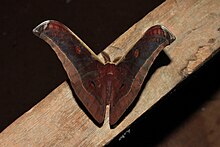
Silk is a natural protein fiber, some forms of which can be woven into textiles. The protein fiber of silk is composed mainly of fibroin and is produced by certain insect larvae to form cocoons. The best-known silk is obtained from the cocoons of the larvae of the mulberry silkworm Bombyx mori reared in captivity (sericulture). The shimmering appearance of silk is due to the triangular prism-like structure of the silk fibre, which allows silk cloth to refract incoming light at different angles, thus producing different colors.

Moths are a group of insects that includes all members of the order Lepidoptera that are not butterflies. They were previously classified as suborder Heterocera, but the group is paraphyletic with respect to butterflies and neither subordinate taxa are used in modern classifications. Moths make up the vast majority of the order. There are thought to be approximately 160,000 species of moth, many of which have yet to be described. Most species of moth are nocturnal, although there are also crepuscular and diurnal species.

The domestic silk moth is an insect from the moth family Bombycidae. It is the closest relative of Bombyx mandarina, the wild silk moth. The silkworm is the larva of a silk moth. The silkworm is of particular economic value, being a primary producer of silk. A silkworm's preferred food is white mulberry leaves, though they may eat other species of mulberry, and even leaves of other plants like the osage orange. Domestic silk moths are entirely dependent on humans for reproduction, as a result of millennia of selective breeding. Wild silk moths are not as commercially viable in the production of silk.

Saturniidae, members of which are commonly named the saturniids, is a family of Lepidoptera with an estimated 2,300 described species. The family contains some of the largest species of moths in the world. Notable members include the emperor moths, royal moths, and giant silk moths.
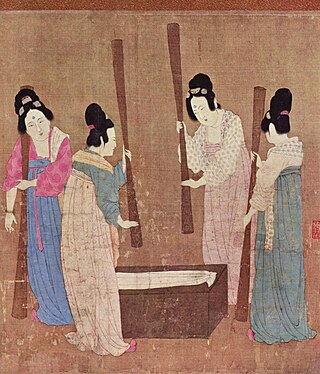
Sericulture, or silk farming, is the cultivation of silkworms to produce silk. Although there are several commercial species of silkworms, the caterpillar of the domestic silkmoth is the most widely used and intensively studied silkworm. Silk was believed to have first been produced in China as early as the Neolithic period. Sericulture has become an important cottage industry in countries such as Brazil, China, France, India, Italy, Japan, Korea, and Russia. Today, China and India are the two main producers, with more than 60% of the world's annual production.

Silk In India, about 97% of the raw mulberry silk is produced in the Indian states of Karnataka, Andhra Pradesh, Tamil Nadu and West Bengal. Mysore and North Bangalore, the upcoming site of a US$20 million "Silk City", contribute to a majority of silk production. Another emerging silk producer is Tamil Nadu where mulberry cultivation is concentrated in Salem, Erode and Dharmapuri districts. Hyderabad, Andhra Pradesh and Gobichettipalayam, Tamil Nadu were the first locations to have automated silk reeling units.
Fibroin is an insoluble protein present in silk produced by numerous insects, such as the larvae of Bombyx mori, and other moth genera such as Antheraea, Cricula, Samia and Gonometa. Silk in its raw state consists of two main proteins, sericin and fibroin, with a glue-like layer of sericin coating two singular filaments of fibroin called brins. Silk fibroin is considered a β-keratin related to proteins that form hair, skin, nails and connective tissues.
Assam silk denotes the three major types of indigenous wild silks produced in Assam—golden muga, white pat and warm eri silk. The Assam silk industry, now centered in Sualkuchi, is a labor-intensive industry.
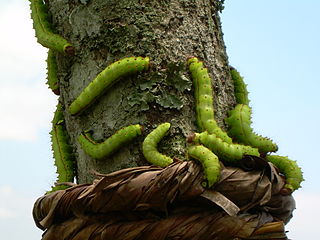
Wild silks have been known and used in many countries from early times, although the scale of production is far smaller than that from cultivated silkworms. Silk cocoons and nests often resemble paper or cloth, and their use has arisen independently in many societies.
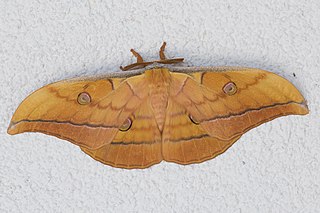
Antheraea is a moth genus belonging to the family Saturniidae. The genus was erected by Jacob Hübner in 1819. Several species of this genus have caterpillars which produce wild silk of commercial importance. Commonly called "tussar silk", the moths are named tussar moths after the fabric.

Tussar silk is produced from larvae of several species of silkworms belonging to the moth genus Antheraea, including A. assamensis, A. paphia, A. pernyi, A. roylei, and A. yamamai. These silkworms live in the wild forests in trees belonging to Terminalia species and Shorea robusta, as well as other food plants such as jamun and oak found in South Asia, eating the leaves of the trees on which they live. Tussar silk is valued for its rich texture and natural, deep-gold colour, and varieties are produced in many countries, including China, India, Japan, and Sri Lanka.

Antheraea pernyi, the Chinese (oak) tussar moth, Chinese tasar moth or temperate tussar moth, is a large moth in the family Saturniidae. The species was first described by Félix Édouard Guérin-Méneville in 1855. Antheraea roylei is an extremely close relative, and the present species might actually have evolved from ancestral A. roylei by chromosome rearrangement.
Antheraeopsis is a genus of moths in the family Saturniidae first described by James Wood-Mason in 1886.

Antheraea paphia, known as the South India small tussore, the tasar silkworm and vanya silkworm is a species of moth of the family Saturniidae found in India and Sri Lanka. The bulk of the literature on this species uses a junior synonym, Antheraea mylitta, rather than the correct name, A. paphia. It is one of a number of tasar silkworms, species that produce Tussar silk, a kind of wild silk that is made from the products of saturniid silkworms instead of the domesticated silkworm.
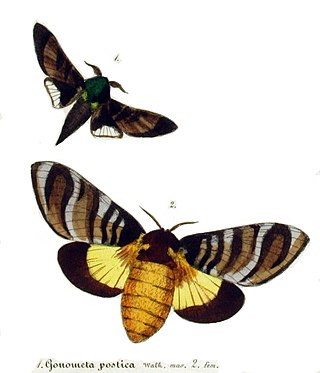
Gonometa postica, known commonly as the African wild silk moth, burn worm, and brandwurm, is a large species of African moth belonging to the family Lasiocampidae. The genus Gonometa boasts some very large moths and larvae; Gonometa sjostedti from Africa has a larva 16 centimeters long, for example. Most of the Lasiocampidae are highly sexually dimorphic. In G. postica the forewing of the male measures 21–25 mm and of the female 35–42 mm.

Muga silk is a variety of wild silk geographically tagged to the state of Assam in India. The silk is known for its extreme durability and has a natural yellowish-golden tint with a shimmering, glossy texture. It was previously reserved for the use of royalty.
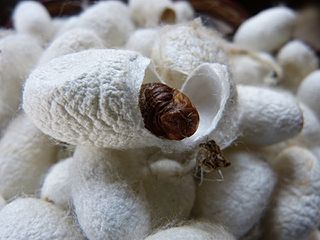
Ahimsa silk is a method of nonviolent silk breeding and harvesting. Wild silk moths are bred, rather than the domestic variety. It allows the completion of the metamorphosis of the silkworm to its moth stage, whereas most silk harvesting requires the silkworms to be killed in their cocoon stage. No animals suffer or die for the silk to be produced, making it a favorable alternative to normal silk for those who object to harming animals.
Martha Rebecca Jane Clokie is a Professor of Microbiology at the University of Leicester. Her research investigates the identification and development of bacteriophages that kill pathogens in an effort to develop new antimicrobials.
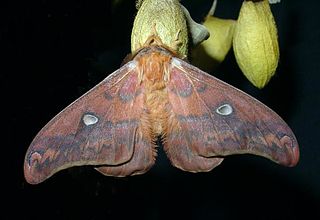
Rhodinia fugax, the squeaking silkmoth, is a moth in the family Saturniidae. It was described by Arthur Gardiner Butler in 1877. It is native to Korea, Japan, China, and the Russian Far East.
